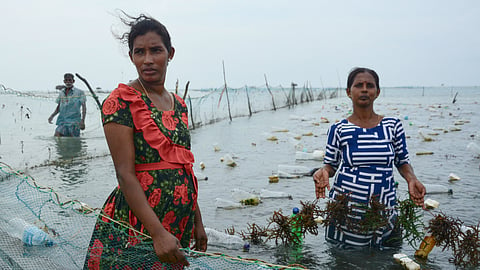Women in Sri Lanka’s North bear the heat
This story was produced with support from Internews’ Earth Journalism Network.
TEMPERATURES ARE RISING again. In the first-ever women-run cashew processing factory in Pooneryn, 20 women wear face-masks, hair nets and aprons over their clothes as they sort, shell, dry and bottle cashews. Vanni Cashew, in Sri Lanka’s war-affected Northern Province, employs women with disabilities or those from female-headed households. The women wear three pairs of gloves, one layered on top of another, to protect their hands from exposure to cashew-nut shell liquid – a reddish-brown substance that, similar to poison ivy, causes skin irritation and peeling. The doors and windows are sealed or netted to prevent the moist coastal air from impacting cashew texture, and to keep the product free of insects and germs. To maintain certification, the women do not deviate from these conditions. They sweat it out for almost seven hours a day, taking the stacked gloves off only during their lunch break and sometimes when they pause for tea.
The heat might soon start eating into the bottom line at Vanni Cashew. Industrial fans and air conditioning are too costly, and a single fan with flimsy plastic blades provides little respite during the hotter months, when the atmospheric temperature routinely exceeds 30 degrees Celsius. At least two employees, unable to bear the stifling indoor heat, have switched to office administration or other work. “Last year, it was so hot the women had to take leave for three or four days until the temperatures became bearable again,” said the manager, Francis Jasmine Jemilla, noting that the women were able to make up for lost time using flexible hours. The workers, who also have caregiving duties at home, have no choice but to forgo work if they suffer from heat exposure, or if heat-related illness strikes a family-member. Last year a heat rash spread across my entire hand,” Jemilla told me. When this happens, the women must take time off from work again. “I used to think of the sun as a friend,” Jemilla said. “But now I’m not so sure.”
According to the World Meteorological Organisation, 2024 was the hottest year on record, and temperatures are only set to increase. In Sri Lanka, extreme heat last year prompted headlines like “Inside an Oven” and forced schools to suspend outdoor sports activities.
A R Warnasooriya, the director of climate-change studies at Sri Lanka’s department of meteorology, said that while the country does not experience heat waves, its flat regions and dry zone – which include the northern, north-central, eastern and southeastern plains – are prone to extreme heat. The 24 weather stations collecting meteorological data across the country every three hours, she added, generally record elevated temperatures in the months of March and April.
By May last year, there were reports that at least seven people had died of extreme heat in the Northern Province. By the end of the century, Sri Lanka’s North is projected to experience wet-bulb temperatures approaching 35 degrees Celsius – a dangerous point beyond which the human body is unable to cool itself. However, little research or media coverage has looked at the lived experiences of workers, particularly women, bearing the brunt of heat in these areas.
Just 22 kilometres southwest of Vanni Cashew, off the coast of Valaipadu, women farm seaweed for export to India. They belong to one of many coastal communities across the Northern Province – including in Kilinochchi, Mannar, Jaffna and Mullaitivu – involved in this fast-growing global industry. Seaweed is a carbon-sequestering consumable, can be a pharmaceutical source and is used as animal feed that does not require any fertiliser for its cultivation.

